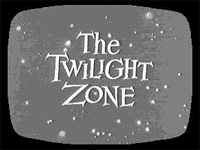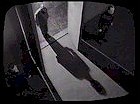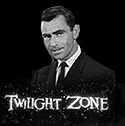| The Twilight Zone and Massurrealism
|  |
Domenic Ali
 Rod Serling’s "The Twilight Zone" [more about this TV program, click here] was one of the most creative and thought-provoking programs in the formative days of television. Serling had complete creative control in the selection and production of the weekly episodes, affording us a unobstructed glimpse into his creative genius. Each episode was striking for its "almost-but-not-quite; the unbelievable told in terms that can be believed" (Rod Serling). This driving theme in Twilight Zone episodes emphasized one of the most critical aspects of surrealist works of art: shifting the emphasis within an image, e.g. exaggerating shadows or intensifying/dimming/removing color, which brings attention to our interpretation of the image. Surrealist artwork helps us experience how the viewer’s emotion, more so than the image’s content, effects the meaning we give to our surroundings. In this respect, the Twilight Zone was an excellent example of how experience could be different even when it remains the same. Rod Serling’s "The Twilight Zone" [more about this TV program, click here] was one of the most creative and thought-provoking programs in the formative days of television. Serling had complete creative control in the selection and production of the weekly episodes, affording us a unobstructed glimpse into his creative genius. Each episode was striking for its "almost-but-not-quite; the unbelievable told in terms that can be believed" (Rod Serling). This driving theme in Twilight Zone episodes emphasized one of the most critical aspects of surrealist works of art: shifting the emphasis within an image, e.g. exaggerating shadows or intensifying/dimming/removing color, which brings attention to our interpretation of the image. Surrealist artwork helps us experience how the viewer’s emotion, more so than the image’s content, effects the meaning we give to our surroundings. In this respect, the Twilight Zone was an excellent example of how experience could be different even when it remains the same.  This paradoxical phrase – different even when the same – is at the heart of numerous Massurrealist images (for an excellent example of this, see the work of Chip Simons [click here] at the massurrealism.org website). Massurrealism, through its unique use of mass media objects, demonstrates how the meaning of consumerism, and the images which represent it, can be significantly different without changing the content of the image (for example Seehafer’s signature shopping cart image [Click here]).
This paradoxical phrase – different even when the same – is at the heart of numerous Massurrealist images (for an excellent example of this, see the work of Chip Simons [click here] at the massurrealism.org website). Massurrealism, through its unique use of mass media objects, demonstrates how the meaning of consumerism, and the images which represent it, can be significantly different without changing the content of the image (for example Seehafer’s signature shopping cart image [Click here]). Such works teach us how to relate to a consumerist society in a way that calls it into question by destabilizing the meaning we usually (and unreflectively) give the modernist world around and through us. Many of the Twilight Zone episodes portray what appears ultra-typical and comforting on the surface yet, when you look more closely, you find something very different. In the “Next Stop, Willoughby” episode, a man is taking the train home after work to go home. Nothing appears out of the ordinary until you realize there is a stop on the train line that doesn’t exist anywhere except in his mind. Eventually the man gets off at this stop and we come to find out he has jumped from the train to his death as a way to escape the quiet desperation of his life. The meaning of an ordinary daily act – commuting – is turned inside out and calls into question one of the quintessential activities of contemporary urban life. One could make similar comments about Chip Simons photograph of a 1950’s housewife, ordinary in every way, except that she is 50-feet tall and brandishing a rolling pin. Again, one of the most comforting icons of American life is destabilized and called into question.
Seehafer’s shopping cart, Simons’ housewife, and episodes like “ A Stop At Willoughby” share the theme of "different even when the same" because they all involve an element (shopping cart, housewife, business man commuting home) that is ordinary and instantly recognizable, yet it is placed in a surrounding (a dark ominous background, mis-matched scaling and different action, daydreaming and disturbing emotions) that generates a different meaning for it. One can imagine transforming these surroundings to the typical ones and the elements would instantly look the "same" as always. In this spirit, it is fair to say Rod Serling was thinking and creating in a Massurrealist manner back in the 1950’s. And what better place for his work to be displayed than the most infamous and ubiquitous objects of 20th century mass media – the television set.
D.P. Ali
August 2005
Rod Serling (December 25, 1924 - June 28, 1975)
Creator of the American television series "The Twilight Zone" (1959 - 1964)
 Born Edwin Rodman Serling, he is best known as a screenwriter for his popular science fiction TV series, The Twilight Zone that ran from 1959 - 1964. He was born in Syracuse, New York to Samuel and Esther Serling. Rod Serling served as an Army paratrooper with the 11th Airborne Division in the Pacific Theater in World War II and was seriously wounded in combat. He suffered from nightmares and flashbacks for the rest of his life. Serling graduated from Antioch College in Yellow Springs, Ohio in 1950.
Though more famous for his groundbreaking and compelling Twilight Zone television series, Serling had later also hosted the weekly series Night Gallery in the 1970s, although he had little creative control. He also narrated documentaries featuring French undersea explorer Jacques-Yves Cousteau. During his lifetime, Rod Serling received six Emmys and his biggest successes in writing include: Patterns (1955), Requiem for a Heavyweight (1956), The Comedian (1957), A Town Has Turned to Dust (1958), The Twilight Zone (1959 - 1964 television series), Night Gallery (1970 - 1973 television series), Planet of the Apes (1968 co-written with Michael Wilson).
He also wrote the pilot episode for a short-lived Aaron Spelling series called The New People in 1969. He later taught at Ithaca College. Born Edwin Rodman Serling, he is best known as a screenwriter for his popular science fiction TV series, The Twilight Zone that ran from 1959 - 1964. He was born in Syracuse, New York to Samuel and Esther Serling. Rod Serling served as an Army paratrooper with the 11th Airborne Division in the Pacific Theater in World War II and was seriously wounded in combat. He suffered from nightmares and flashbacks for the rest of his life. Serling graduated from Antioch College in Yellow Springs, Ohio in 1950.
Though more famous for his groundbreaking and compelling Twilight Zone television series, Serling had later also hosted the weekly series Night Gallery in the 1970s, although he had little creative control. He also narrated documentaries featuring French undersea explorer Jacques-Yves Cousteau. During his lifetime, Rod Serling received six Emmys and his biggest successes in writing include: Patterns (1955), Requiem for a Heavyweight (1956), The Comedian (1957), A Town Has Turned to Dust (1958), The Twilight Zone (1959 - 1964 television series), Night Gallery (1970 - 1973 television series), Planet of the Apes (1968 co-written with Michael Wilson).
He also wrote the pilot episode for a short-lived Aaron Spelling series called The New People in 1969. He later taught at Ithaca College.
[1] The Twilight Zone is generally considered to be the first real "adult" science-fantasy anthology series to appear on American television, introducing the late 1950s TV audience to an entertaining and at the same time thought-provoking collection of human condition stories wrapped within fantastic themes. Although the series is usually labeled a science fiction program its true sphere was fantasy, embracing elements of the supernatural, the psychological, and "the almost-but-not-quite; the unbelievable told in terms that can be believed" (Rod Serling).
 [2] The Twilight Zone was an inventive blend of science fiction that understood what the full spectrum of science fiction really is.
Most people think that science fiction only entails stories about the future or about outer space or horrible creatures spawned out of man's reckless follies. For fans of that aspect of sci-fi, THE TWILIGHT ZONE offered many fine shows. But for those who wanted to visit the world of inner space, a concept rarely ever explored in cinema or television up to that point, this was truly a mind-bending experience! Alternative forms of reality, be they physical dimensions not yet understood by science, or avenues of the human psyche that can only be interpreted through surrealism and psychology, were all portrayed with incredible imagery and with an essential belief in the dignity of the human spirit. For at the end of the day, science is not just abstract calculations and theories. It involves the very miracle of the universe and the meaning of our paltry existence in it. We must pay our debt to the mystery that is beyond our knowledge or even our imagination. For some, religion is the ritual of that debt. For others, art is the avenue that brings one in alliance with the awe of the mysteries of the universe. It is no understatement that THE TWILIGHT ZONE was art. Its blend of aesthetics, concepts, and visionary ideals set it apart from mere entertainment. [2] The Twilight Zone was an inventive blend of science fiction that understood what the full spectrum of science fiction really is.
Most people think that science fiction only entails stories about the future or about outer space or horrible creatures spawned out of man's reckless follies. For fans of that aspect of sci-fi, THE TWILIGHT ZONE offered many fine shows. But for those who wanted to visit the world of inner space, a concept rarely ever explored in cinema or television up to that point, this was truly a mind-bending experience! Alternative forms of reality, be they physical dimensions not yet understood by science, or avenues of the human psyche that can only be interpreted through surrealism and psychology, were all portrayed with incredible imagery and with an essential belief in the dignity of the human spirit. For at the end of the day, science is not just abstract calculations and theories. It involves the very miracle of the universe and the meaning of our paltry existence in it. We must pay our debt to the mystery that is beyond our knowledge or even our imagination. For some, religion is the ritual of that debt. For others, art is the avenue that brings one in alliance with the awe of the mysteries of the universe. It is no understatement that THE TWILIGHT ZONE was art. Its blend of aesthetics, concepts, and visionary ideals set it apart from mere entertainment.
Serling died due to complications from heart bypass surgery and is interred in the cemetery in Interlaken, New York.
Cited :
[1] The Museum of Broadcast Communications
| | [2]
The Twilight Zone Page
|
Additional references sources :
Rothenberg, Randall. "Synergy of Surrealism and The Twilight Zone." The New York Times, 2 April 1991.
|
Special thanks :
The Rod Serling Foundation Binghamton, New York, U.S.A. |
|
|
|
 | 
|
|
|
|